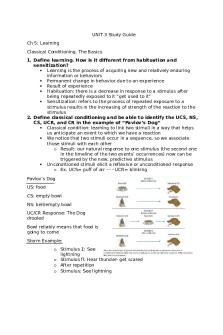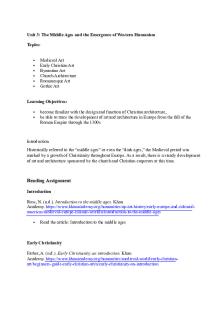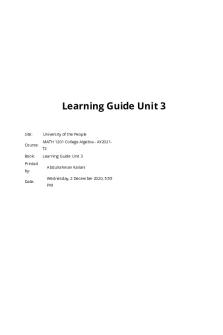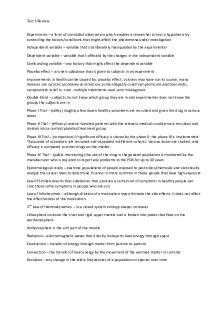Major Review - Unit 3 - Study Guide Unit 3 PDF

| Title | Major Review - Unit 3 - Study Guide Unit 3 |
|---|---|
| Author | alyssa riverna |
| Course | Survey of Chemistry I |
| Institution | Kennesaw State University |
| Pages | 3 |
| File Size | 117.2 KB |
| File Type | |
| Total Downloads | 67 |
| Total Views | 168 |
Summary
Study Guide Unit 3...
Description
Major Review - Unit 3 Major Review - Unit 3 DISCLAIMER FOR MAJOR REVIEWS SI Major Review Sessions are intended as a supplement to assist your preparations for tes exams. Unlike regular sessions, they are fast paced review sessions and time for questions w be limited. Please keep these things in mind: 1. Major Reviews should not be your only avenue to prepare for your quizzes, tests and exa 2. Major Reviews are not typical of a regular SI session. 3. Major review and any practice tests utilized in the review are to be used as study aids! Th not necessarily have all the material that may be covered on the test, and the SI leader cannot promise this will be exactly like the actual test. 4. SI Leaders do not write or have the actual test or exam. Although Major Reviews are beneficial to many students, they are NOT intended to replace study time. Only you will be able to determine the extent to which you will need to study to prepared for exams. a. Increases
b. Decreases
c. Stays constant
1. If the temperature of a gas in a balloon increase, the volume of the gas : 2. If you increase the volume of a gas at constant temperature, the pressure : 3. When you push in the plunger of a syringe, the pressure : 4. If you increase osmolarity, freezing point : a. 1.0 M NaCl
b. 1.5 M CaCl₂
c. 2.0 M AlCl₃
d. 4.0 M C₆H₁₂O₆
5. Which boils at the highest temperature? 6. Which boils at the lowest temperature? 7. Which freezes at the highest temperature? 8. Which freezes at the lowest temperature? a. NaCl
b.SrSO₄
c. HgCl₂
9. Which of these are soluble? 10. Which are insoluble? a. reactant
b. Product
d.KNO₃
e.NH₄Br
f. KOH
14. If constant K equals 112, which is favored? 15. In constant K equals 0, which is favored? 16. If constant K equal .021, which favored? 17. The bubbles inside boiling water are filled with : a. Air
b. Water
c. Oxygen
d. NONE
18. How many grams of CH₄ are needed to make 14.2 L of gas at 45 degrees Celsius with 2.00 atm? a. 1.08 moles CH₄
b. 17.34 g CH₄
c. .0043 g CH₄
d. 17 g CH₄
e.
19. What volume of a solution is needed to turn 15.5 mL of 4.00 M NaOH into a 1.35 M a. .191 mL b. 54.9 mL c. 45.9 mL d.46 mL 20. Based on the above question, how much H₂O was added to make the solution? a. 15.7 mL b. 39.4 mL c. 30.4 mL d. 30.5 mL 21. What volume of a solution is needed to turn 7.50 g of NaCl into a 0.987 M NaCl solut a. 0.13 L
b. 2.12 L
c. 0.130 L
d. 0.130 mL
e. None
22. 17.3 grams of NaCl is dissolved to make 175 mL of solution. What is the percent conc a. .0989 % (m/v)
b. 10.1 % (m/v)
c. 10.1 % (v/v)
d. 9.89 % (m/v)
23. Calculate the Osmolarity : a. 3.0 M Al₂(SO₄)₃ b. 2.0 M KCl c. 2.0 M NaOH d. 1.15 M C₂H5NO₂
24. Based on the above, which would rise in a U-Tube? A or B
B or D
B or C
A or D
25. Balance the equation. Write the equilibrium expression. Solve for K. Are reactants or pro HCl (aq) + H₂O (l) ↔ H₃O (aq) + Cl (aq) [H₃O] = 1 00 E3
If its an endothermic reaction and you remove heat?...
Similar Free PDFs

Unit 3 study guide - unit test 3
- 3 Pages

UNIT 3 Study Guide
- 19 Pages

Unit 3 Study Guide
- 4 Pages

Unit 3 Study Guide - notes
- 8 Pages

Student Study Guide Unit 3
- 13 Pages

Learning Guide Unit 3
- 20 Pages

Unit 3 Study Questions
- 12 Pages

Unit 3 homework - unit 3
- 4 Pages

ENG 214 Unit 3 Test Study Guide
- 7 Pages

MATH 215 C10 - Study Guide Unit 3
- 19 Pages

Unit 3 Study Guide Spring 2020
- 3 Pages

Unit 2 Exam Study Guide Micro -3
- 17 Pages

ENGL 255 Unit 3 study guide
- 5 Pages
Popular Institutions
- Tinajero National High School - Annex
- Politeknik Caltex Riau
- Yokohama City University
- SGT University
- University of Al-Qadisiyah
- Divine Word College of Vigan
- Techniek College Rotterdam
- Universidade de Santiago
- Universiti Teknologi MARA Cawangan Johor Kampus Pasir Gudang
- Poltekkes Kemenkes Yogyakarta
- Baguio City National High School
- Colegio san marcos
- preparatoria uno
- Centro de Bachillerato Tecnológico Industrial y de Servicios No. 107
- Dalian Maritime University
- Quang Trung Secondary School
- Colegio Tecnológico en Informática
- Corporación Regional de Educación Superior
- Grupo CEDVA
- Dar Al Uloom University
- Centro de Estudios Preuniversitarios de la Universidad Nacional de Ingeniería
- 上智大学
- Aakash International School, Nuna Majara
- San Felipe Neri Catholic School
- Kang Chiao International School - New Taipei City
- Misamis Occidental National High School
- Institución Educativa Escuela Normal Juan Ladrilleros
- Kolehiyo ng Pantukan
- Batanes State College
- Instituto Continental
- Sekolah Menengah Kejuruan Kesehatan Kaltara (Tarakan)
- Colegio de La Inmaculada Concepcion - Cebu


